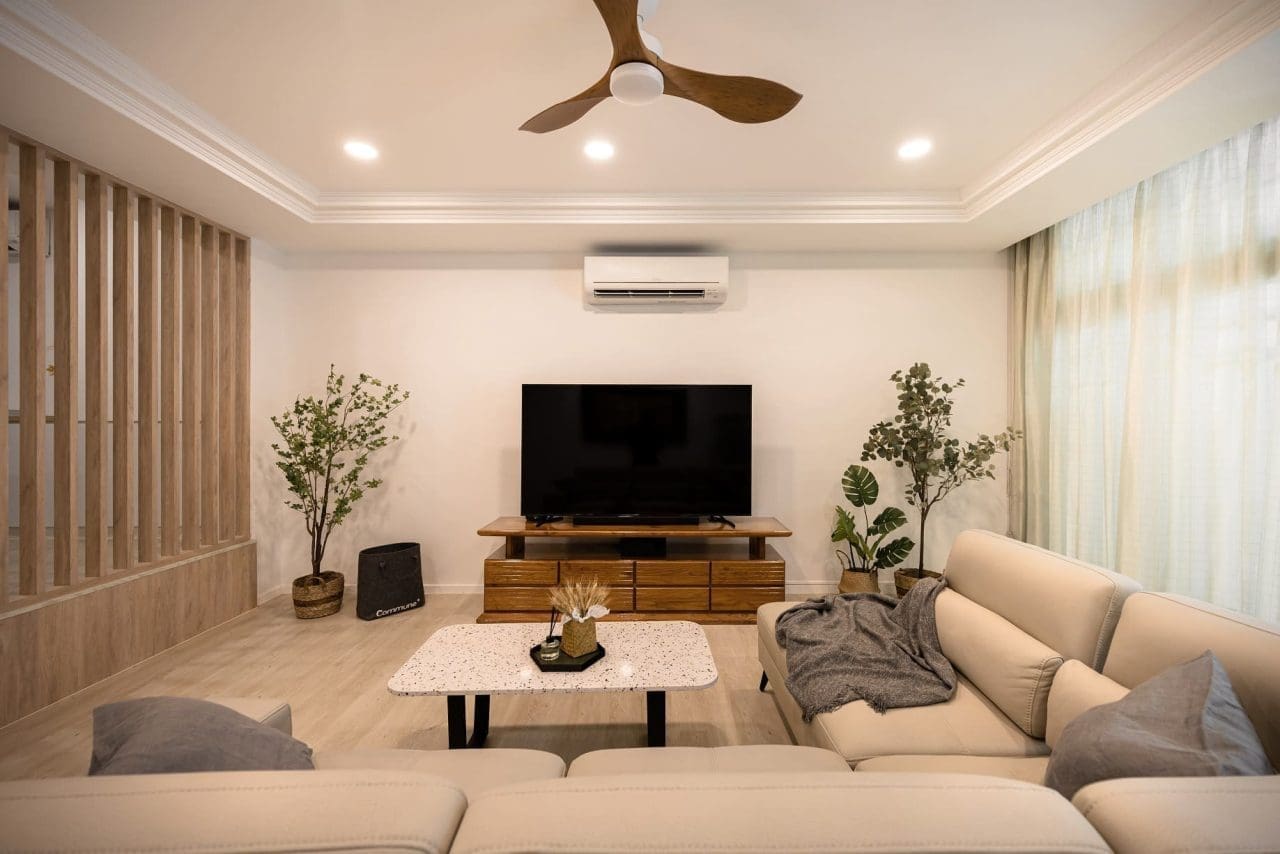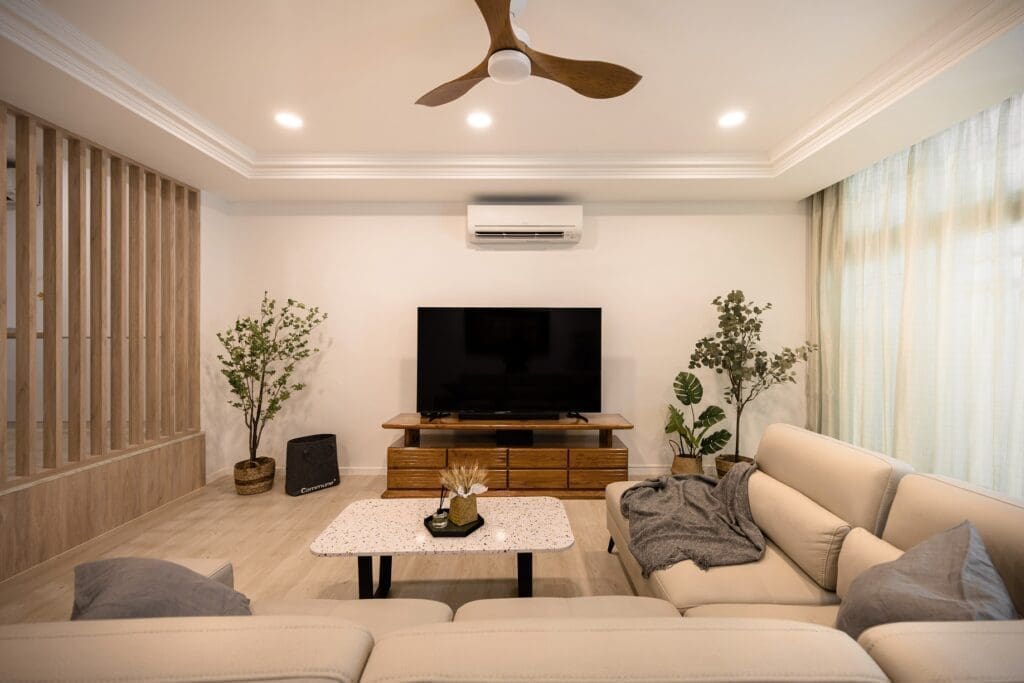Table of Contents
ToggleLiving Room Design Singapore: Deciding on the Ambiance You Want
Develop an idea of the mood you want to create
The tone, character, and atmosphere of an area are referred to as ambiance. Ambiance has a significant impact on the mood that a space evokes. Consider what role you’d like the room to perform in your life. The following are some of the most crucial considerations:- What do you do in the room (watch TV, entertain guests, read, etc.)?
- When do you often use the living room?
- Do you want the space to energize or rest you?
- Do you let sunshine in via the windows on a regular basis?
Take advantage of natural light
Certain color combinations are best suited to brightly lit areas. Color the walls in saturated jewel tones or earthy colours if the living room will be used during the day and is particularly well-lit by the sun.- In the sun, bright colors like sapphire blue or emerald green look fantastic.
- Dark earthy tones, therefore, only work in places with plenty of natural light, as the light stops the living room from appearing too dark.
- It’s worth noting that these hues are overbearing in low light, therefore they shouldn’t be used in dimly lit areas.
- Keep in mind that wallpaper will fade with time if it is installed in a space with a lot of natural light.
Lighten up a dark room with sunny hues
If, on the other hand, your living room doesn’t get a lot of natural light or you plan to spend a lot of time there in the evening, there are some colors that can help lighten it up.- Ivory and buttercup yellow, especially when used prominently, can make a dark living room appear lighter.
- Light greens and blues can also be used to make a low-light environment look cheerful and cheery.
Create a warm space with warm tones
The warmth of a room is a related, but unique, factor to consider. Deep reds, burned oranges, and nearly all shades of gold and brown can be used to create a warm, glowing environment that is ideal for a living room.- These color schemes are ideal for living spaces that are utilized both during the day and at night, as they prioritize comfort above energy while remaining light enough for daily use.
- However, avoid utilizing strong tones of red or orange as dominant or secondary colors, as these colors have a lot of energy and can be overwhelming if used in excess.
- Deep yellows, browns, and rusty reds, for example, may warm up a room and look wonderful in any light.
Sticking with Proven Palette Approaches
Follow the 60-30-10 rule
Notwithstanding the shadings you pick, it’s useful to arrange for how much space each shading will represent. As a dependable guideline, 60% of your lounge ought to be a prevailing tone, 30% ought to be an optional shading, and 10% ought to be a highlight tone.- Pick predominant and auxiliary tones you’re particularly OK with. Realize that your predominant shading decision will significantly affect the room’s vibe. Try not to pick a predominant or auxiliary shading that you are not certain beyond a shadow of a doubt of.
- Just utilize intense shadings as complement tones. A punch of incredible shading can do miracles to the energy and character of a space. Have this kind of effect with your emphasize shading. For a feeling of imperativeness, make your highlight tone the most brilliant of your range.
- Guarantee that each of the 3 tones arrange well with each other. Assemble your picked colors in a little preliminary region prior to focusing on painting and finishing the entire room.
- You should utilize an unbiased shading as a base, similar to beige or dark, as they are flexible and exemplary.
Match the color scheme of your furnishings.
For example, if you have modern furniture and decorations, you’ll probably be better off with a modern color scheme of white, black, and gray rather than a conventional color scheme of deep hues.- If you have older or more conventional furnishings, use bright, modern paint and accent colors to bring the space up to date.
- If your furniture has a similar color scheme, complementing it with a secondary or accent color will help to connect the room together.
Stick with white for a simple, clean option
The safest bet is to go with white. While some people prefer a more interesting dominating color, there’s no disputing that an all-white or mostly-white living room may seem incredibly clean and crisp. Off-white, cream, eggshell, grey-white, or antique white are just a few of the “whites” available.Going Your Own Way with Color Selection
Familiarize yourself with the color wheel
You need have a broad notion of where the colors on the wheel are in relation to one another in order to know how to balance them. Complementary colors—those on the polar opposite ends of the color wheel—usually go well together.Pair complementary colors
Because complimentary hues are effectively diametrically opposed, they work together to make one another “pop” or stand out. Red and green, orange and blue, and yellow and violet are examples of complementary colors. Because complementary colors are so strong, you might want to choose milder hues of the colors you like. Bright complementing color tones might be overwhelming to the eyes, while muted colours can give your living area a nice buzz of energy.Compare swatches before painting or buying furniture and accents
If you’re not sure how a potential color scheme will turn out, compare paint cards, fabric swatches, and other color samples side by side. Bring samples and paint cards home with you and display them in the areas where you plan to use them.- Use this as a practice run before investing time and money in paint and furnishings.
- Fabric swatches can be acquired at furniture stores, while paint cards can be found at hardware stores and paint suppliers. Manufacturers can send one of these items directly to your home.
Get inspiration from a prominent piece in the room
In case you’re experiencing difficulty settling on a shading plan, look no farther than the items you expect to keep in the room. Noticeable bits of craftsmanship or furniture can enormously supplement (and be supplemented by) the shading plan you pick. Anticipating what you mean to have in the room will likewise guarantee that your shading plan facilitates with the most recognizable pieces in your lounge.- In the event that you have a designed love seat, for example, grab tones from that example to make your general shading plan.
- In the event that you have a piece of fine art that you need to rule the space, play to its conspicuousness with the tones you pick. You may coordinate with your complement tone to a noticeable shading highlighted in the piece, for example.
- You could likewise get motivation from a model or embellishment. Carry the thing to the store with you to help you match paint, window medicines, or different decorations to it.







